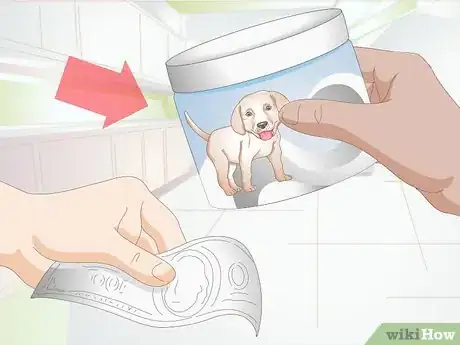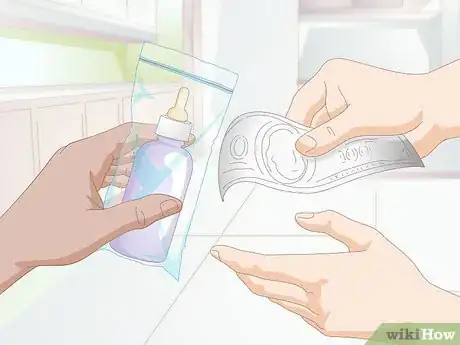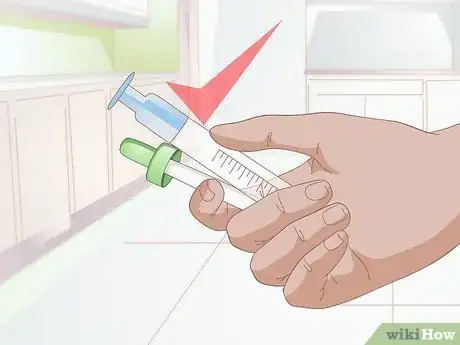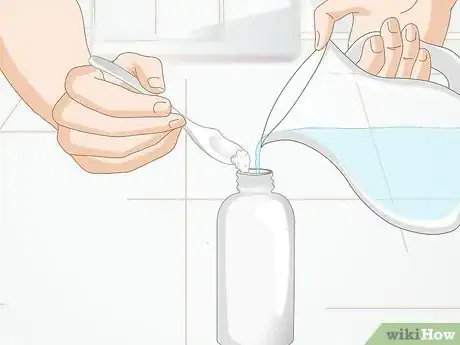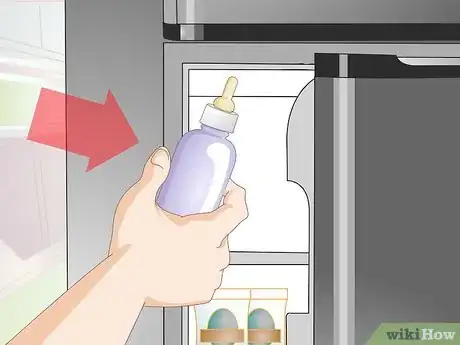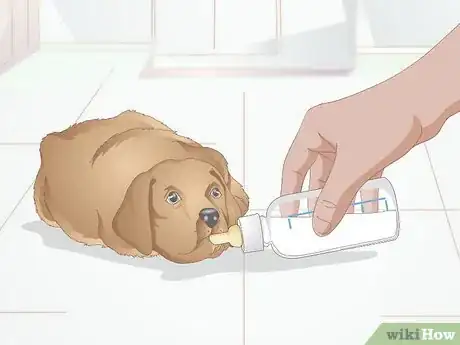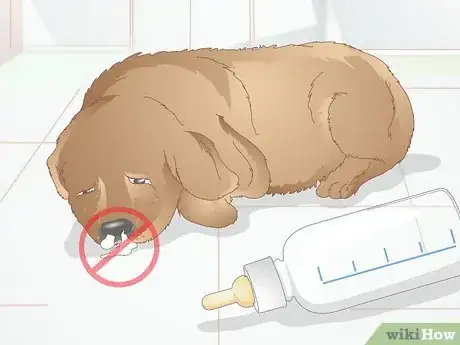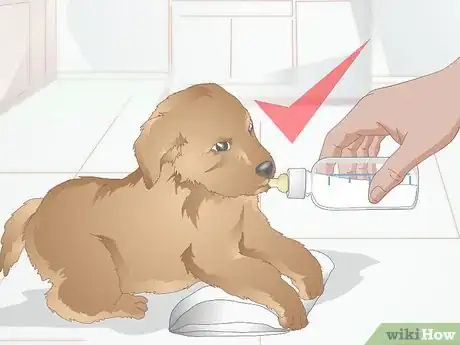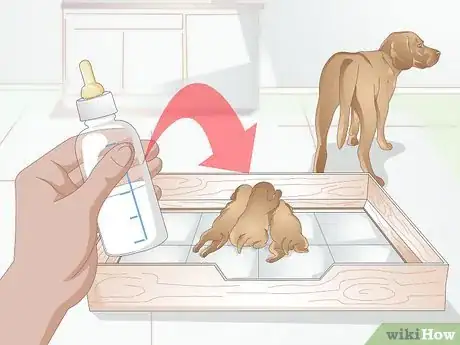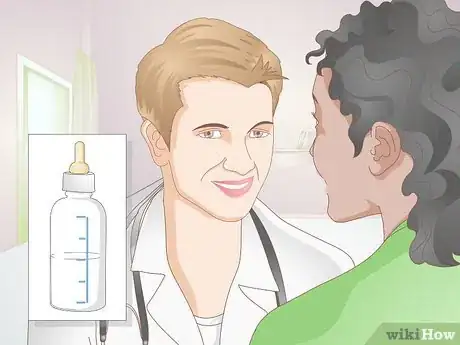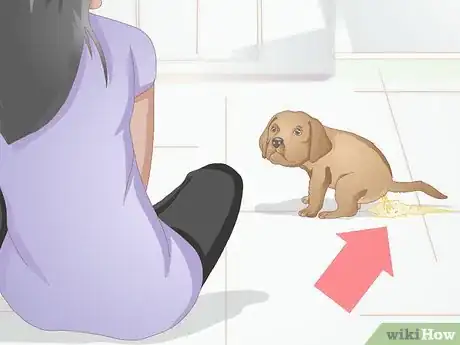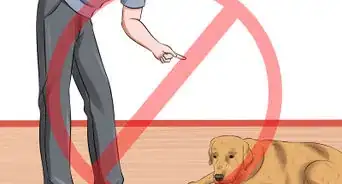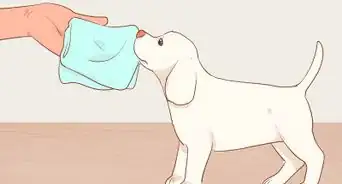This article was co-authored by Ray Spragley, DVM. Dr. Ray Spragley is a Doctor of Veterinary Medicine and the Owner/Founder of Zen Dog Veterinary Care PLLC in New York. With experience in multiple institutions and private practices, Dr. Spragley’s specializations and interests include non-surgical management of cranial cruciate ligament tears, Intervertebral Disk Disease(IVDD), and pain management in osteoarthritis. Dr. Spragley holds a BS in Biology from SUNY Albany and has a Doctor of Veterinary Medicine degree (DVM) from Ross University School of Veterinary Medicine. He is also a Certified Canine Rehabilitation Therapist (CCRT) through the Canine Rehab Institute as well as a Certified Veterinary Acupuncturist (CVA) through Chi University.
This article has been viewed 24,335 times.
Most puppies will successfully nurse from their mother. However, circumstances can arise where you will need to formula feed your puppy to ensure their survival. To do this, you need to get the proper ingredients, prepare the formula, and feed the puppy with a bottle or eyedropper.
Steps
Gathering the Ingredients
-
1Buy a puppy formula. When feeding your puppy formula, you need to make sure that you buy the right kind of formula. Puppies have specific nutritional needs, so you need make sure the formula is specifically for puppies.[1]
- You can get puppy formula from the vet or from a pet store.
- There are dry or canned varieties. Either type is fine, but dry is more cost-efficient in the long run.
-
2Purchase a puppy bottle. To feed your puppy, you should get a puppy nursing bottle. This holds a small amount of formula. You can purchase one of these bottles at a pet store.[2]
- When you get the bottle, you will need to put a hole in the nipple. Use a flame-heated needed. Put two small holes in the point of the nipple.
- Make sure the holes are only big enough to let a few drops of milk to come out.[3] Holes that are too large can lead to the puppy getting formula in the lungs. Holes that are too small will lead to too much air.
Advertisement -
3Use an eyedropper or syringe if the puppy is too small. Toy or tiny breeds may be too small to feed from a bottle when they are first born. If this is the case, you should use an eyedropper. If the puppy can't suckle yet, you can gently squeeze the formula into the side of the mouth.[4]
- You can also use a syringe to squeeze the formula into the mouth.
- Don't squeeze the milk directly into the back of the puppy's mouth. It could lead to choking.
Preparing the Formula
-
1Blend the formula well. When you are preparing dry formula, make sure that you mix it together very well. Get rid of all clumps or pockets of dry formula. It should all be blended and smooth.[5]
- Wait for the bubbles to get out of the formula before feeding it to the dogs.
-
2Get the formula to the right temperature. Before you give the puppy formula, you need to get it to the right temperature. Place the bottle in a mug or bowl of hot water. Don't heat the formula itself in the microwave or in a pot.[6]
- Put the formula on your wrist to test the temperature. It should be warm, but not hot.
-
3Store the formula properly. Make sure to keep your formula stored properly to keep your puppy safe. After mixing or opening formula, you keep it in the refrigerator and use it all day. However, you should throw away the leftover formula at the end of the day.[7]
- If you use dry formula, you can keep the canister in the freezer. Don't place the cans in the freezer.
Feeding the Puppy
-
1Give your puppy the correct amount of formula. You should make sure to feed your puppy the correct amount of food each day. This ensures they grow at the right weight and gain weight at the proper rate. These are approximate. Make sure to only feed the puppy until the belly is a gentle round shape. Divide the total for the day by the number of feedings per day.[8]
- In the first week, feed the puppy around 25 to 35 milliliters (0.8 to 1 fl oz) for every 100 grams (3.5 oz) of body weight. In week two, try 15 to 20 milliliters (0.51 to 0.68 fl oz) for every 100 grams (3.5 oz). Week three and four, give 20 mL for every 100 grams.
-
2Feed the puppy regularly. You should give the puppy food every two to three hours. This is around eight to ten meals per day. At three weeks, you can feed the dog around six times each day. At five weeks, the puppy should be eating solid foods, but you can still feed them formula two to three each day.[9]
- Make sure to burp the puppy after feeding. Hold the puppy with their belly against your shoulder. Gently pat the puppy on the back until it burps.
-
3Make sure not to overfeed the puppies. Puppies may not know when to stop eating. This can lead to overfeeding. Overfeeding may lead to health problems, like milk in the lungs, pneumonia, or diarrhea.[10]
- Feed the puppy many small meals through the day instead of less larger meals.
- Make sure there are no bubbles of milk coming out of the puppy's nose. This can point to overfeeding.
-
4Feed the puppy correctly. Make sure the puppy is on their stomach.[11] Place the nipple in the puppy's mouth and press the bottle enough so that one to two drops of milk come out. This will help the puppy figure out that the milk is in the nipple, and they will start to suck.[12]
- Don't place the puppy upside down, upright, or on their back to feed them.
- Avoid dripping the formula into the puppy's mouth since it could cause aspiration.[13]
-
5Clean the materials properly. Between each use, you should clean the materials. This ensures that you don't contaminate the formula and make the puppy sick. Clean the bottles, syringes, eyedroppers, and other material by boiling them for 10 minutes. Do this after every feeding.[14]
- If you're using syringes, make sure to remove the plungers.
Ensuring the Success of Your Puppy
-
1Know when to formula feed your puppy. There are a few reasons why you may need to formula feed your puppy. You may need to help if you have a mother dog who is struggling to feed her puppies or who cannot produce milk. Some mother dogs will neglect their puppies. If the mother dog dies, you will have to feed the puppies.[15]
- You should also formula feed runts, which are the dogs that have body weights that are at least 20 percent less than the rest of the litter.
-
2Consult your veterinarian. Though you will be doing the work of feeding your puppies, you should contact your veterinarian. Tell your veterinarian that you are bottle feeding your puppies. The vet can give you advice and help you if you run into any problems.[16]
- You have probably been in contact with your vet about your puppy, so just let them know during one of your visits you are formula feeding the puppy.
-
3Look for any problems. Puppies can fade fast if something goes wrong. Look for symptoms of nutritional problems like diarrhea, decreased saliva, depression, weakness, limpness, and frigid skin. If any of these things occur, you should consult your veterinarian.[17]
- Pay attention to the puppy's stool. Stools with clumps happen when the formula is too thick and concentrated. Dilute the formula and increase the frequency of feeding. You can put pedialyte in the formula if the puppy has diarrhea.
Community Q&A
-
QuestionHow long should a puppy be on formula?
 Adele OrrTop AnswererThe puppy should be on formula alone for about 4 weeks. At 4 weeks old, you can begin introducing solids. Slowly reduce the amount of formula and increase the solids for another 4 weeks. By the time the puppy is 8 weeks old, it should be eating only solids.
Adele OrrTop AnswererThe puppy should be on formula alone for about 4 weeks. At 4 weeks old, you can begin introducing solids. Slowly reduce the amount of formula and increase the solids for another 4 weeks. By the time the puppy is 8 weeks old, it should be eating only solids.
References
- ↑ http://www.fidosavvy.com/how-to-bottle-feed-puppies.html
- ↑ http://www.2ndchance.info/orphanpuppy.htm
- ↑ Ray Spragley, DVM. Veterinarian. Expert Interview. 19 August 2021.
- ↑ http://www.fidosavvy.com/how-to-bottle-feed-puppies.html#Hand
- ↑ http://www.2ndchance.info/orphanpuppy.htm
- ↑ http://www.hartz.com/Dogs/Hartz_Puppy/bottle_feeding_the_newborn_puppy.aspx
- ↑ http://www.2ndchance.info/orphanpuppy.htm
- ↑ http://www.2ndchance.info/orphanpuppy.htm
- ↑ http://www.all-about-goldens.com/bottle-feeding-puppies.html
- ↑ http://www.hartz.com/Dogs/Hartz_Puppy/bottle_feeding_the_newborn_puppy.aspx
- ↑ Ray Spragley, DVM. Veterinarian. Expert Interview. 19 August 2021.
- ↑ http://www.hartz.com/Dogs/Hartz_Puppy/bottle_feeding_the_newborn_puppy.aspx
- ↑ Ray Spragley, DVM. Veterinarian. Expert Interview. 19 August 2021.
- ↑ http://www.2ndchance.info/orphanpuppy.htm
- ↑ http://www.2ndchance.info/orphanpuppy.htm
- ↑ http://www.fidosavvy.com/how-to-bottle-feed-puppies.html
- ↑ http://www.2ndchance.info/orphanpuppy.htm
About This Article
To formula feed your puppy, first make sure that you buy formula made specifically for puppies’ nutritional needs. Then, buy a puppy nursing bottle or get an eye dropper or syringe if your puppy is too small to use a bottle. To prepare dry formula, blend the powder with the recommended amount of water completely. Then, warm the bottle by placing it in a bowl of hot water so it will be comfortable for your puppy to drink. Once the formula is warm enough, make sure your puppy is sitting upright on its stomach. Puppies don’t usually know when to stop eating, so be sure you don’t give your puppy more than its recommended amount. For more information from our Veterinary co-author, like how to clean your feeding supplies, keep reading!
